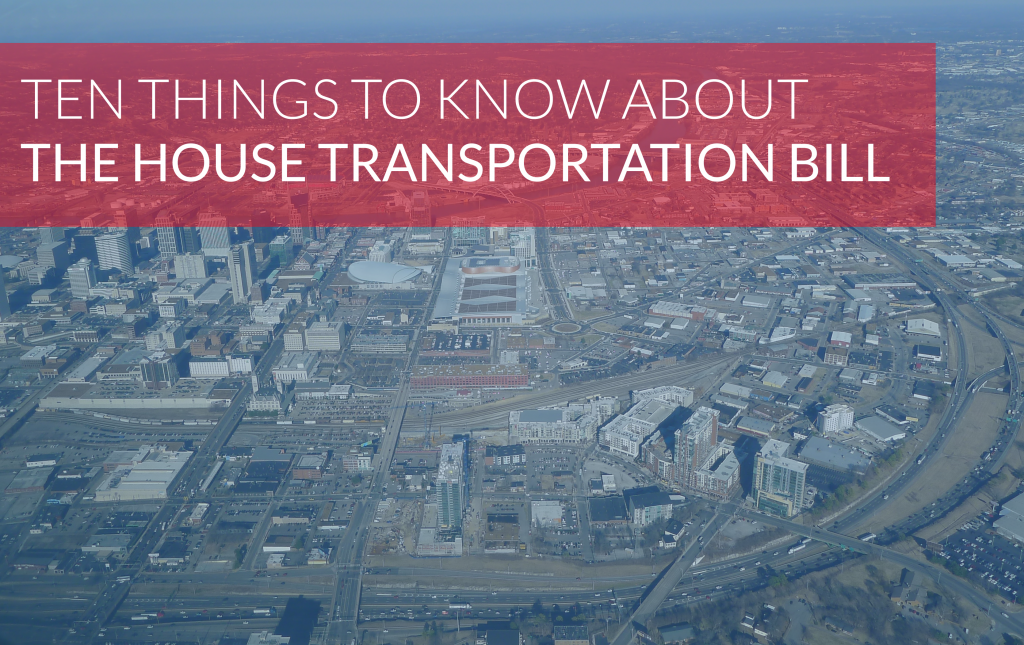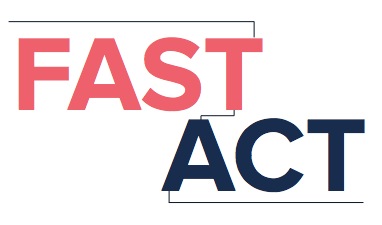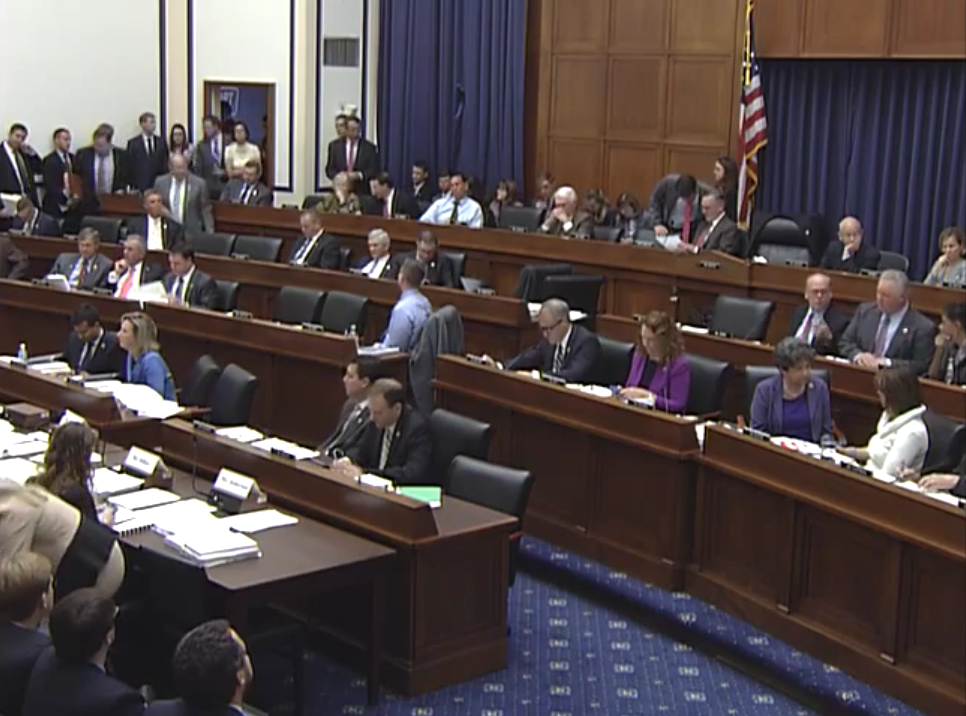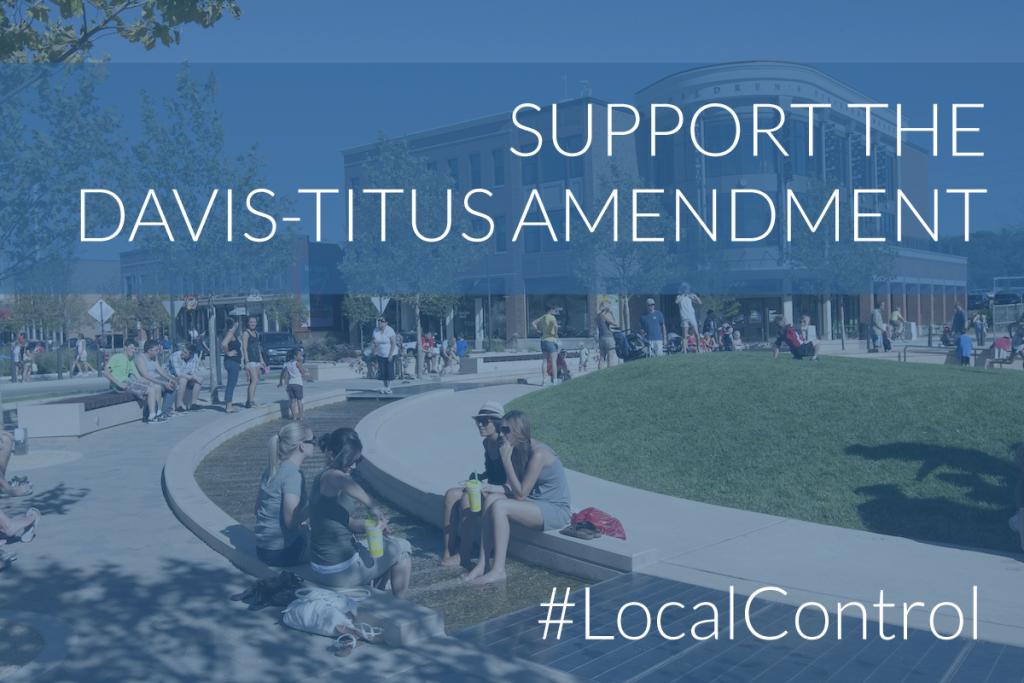Updated 11/5/2015 5 p.m. EST. We wrote this post in preparation for consideration of this bill on the House floor. But after the House finished consideration of the bill on Thursday (11/5), we updated this post to reflect the changes made (or not made) over the last few days. Look for the updated notes in the blue boxes with each item below and read our full statement on the bill here. -Ed.
The House Transportation and Infrastructure (T&I) Committee debated and approved their multi-year transportation reauthorization proposal last week. Next step is consideration on the House floor and then, if approved, conferenced (merged through negotiations) with the Senate, which passed their multi-year DRIVE Act back in July. Here are ten things you need to know about what’s in (or not in) the House bill which is expected to be considered on the House floor early next week.

1) The House will likely tap the same non-transportation revenue sources as the Senate did to pay the tab
Though the House has yet to officially pass a plan to pay for their bill (unlike the Senate), we expect them to closely emulate the Senate plan to cobble together about $45 billion from numerous future funding sources to fully cover the cost of the first three years of their bill. Though as many as 10 years would be needed to realize some of the new revenues to cover the next three years of spending, it would instantly transfer billions from the general fund to the transportation fund, increasing the deficit, a practice that Senator Bob Corker (R-TN) called “generational theft.” We’ve already tapped general taxpayer dollars to the tune of $73 billion over the last few years to keep the nation’s transportation trust fund solvent.
One factor possibly complicating this plan is that the House and Senate just reached a separate budget agreement (to keep the government operating) that also requires selling oil from the country’s Strategic Petroleum Reserve — a mechanism that comprised the second largest stream of funding for the Senate’s bill. If that expected $9 billion in revenue for the DRIVE Act is no more, how will the House fill this gap?
For a detailed rundown of the Senate’s funding plan the House is expected to emulate, read our ten things post on the Drive Act.
Updated: The House did indeed use the Senate funding sources as their starting point, but there was a fairly stunning development late on Wednesday night when an amendment was proposed that taps billions from a Federal Reserve surplus account; an amount that could be sufficient to fund the bill for a full six years. It may be one way to allow other contentious payfors from the Senate to be removed — the dividend rate change for banks among them — but it could also nearly double the amount of money available. We’ll be watching this closely as more news develops.
2) Enshrines three more years of policy into law than we can pay for
The Senate bill — and we expect the House bill to follow suit as covered above — authorizes the surface transportation program for six full years but includes a funding plan that can only cover the first three years of the bill. The bill would use $46 billion in future offsets to cover its three-year length, leaving a future Congress to find another $50 billion or so to pay for the last three years. We’d be the first to say that we urgently need the certainty and stability that a multi-year bill provides to states and local communities as they plan transportation investments, but this is unprecedented and it’s incredibly shortsighted to lock our country’s transportation policy in stone for six years when we aren’t willing to pay for it. Especially when we’re enshrining transportation policy into law for the next six years, which simply doesn’t do enough to meet the needs of local communities of all sizes. Which leads us to…
Updated: Per the point above, it’s unclear just how much funding is going to be available. Enough funding for the first three years will be transferred, but the new funding sources tapped via amendment on Wednesday will provide far more funding and could be enough for the full six years of the House bill. Leadership will have decisions to make about what to do with the additional funding.
3) Misses a golden opportunity to provide more funding to local communities
The House bill is a major missed opportunity for giving cities, towns and local communities of all sizes greater access and control over federal transportation dollars. An amendment from Representatives Davis (R-IL) and Titus (D-NV), with broad bipartisan support, would direct more flexible funding to towns and cities and increase transparency in how projects are selected, but it was not included by the committee. Representatives Davis and Titus will be offering this amendment on the floor and we are going to need your help to make sure it gets into the bill.
Just like the Senate, the House bill does slightly increase the share of the bill’s most flexible funds that go to local communities by five percent (up to 55 percent of just one of many core highway programs), but that improvement only happens incrementally over the six years of the bill. This means that the full increase comes in the later years of the bill that likely won’t be paid for anytime soon — see #2 above. The House bill does lower to $10 million the minimum cost of projects that can apply for low-cost TIFIA loans, making it easier for local communities to access this smart federal financing program, but far more must be done to ensure that towns and cities both big and small have the resources and control they need to stay to invest in the infrastructure they need to be economically competitive.
Updated: The Davis-Titus amendment was not allowed to be brought to the floor by the House Rules Committee, despite the significant bipartisan support — among the most for any amendment offered. This means that there was no airing of the argument on the House floor and no chance for even debating the merits of giving local communities more control or authority over transportation dollars. This was a major point of contention raised in our final statement on the bill.
4) Includes a freight program to help states and metro areas address goods movement issues, but needlessly limits innovative multimodal projects
Similar to the DRIVE Act, the House bill encourages crafting a multimodal freight plan but only about 10 percent of the new roughly $725 million per year discretionary freight grant program can be spent on multimodal projects. This means that the House is dictating from Washington exactly how states and metro areas should solve their freight challenges, robbing them of the flexibility to invest in whatever option can best keep freight moving.
This flies in the face of past statements from this same committee, which stated clearly in a report three years ago that our freight issues are multimodal and require multimodal solutions. “Moving goods and people effectively depends on all modes of transportation,” said Chairman Shuster in that report. “Because bottlenecks at any point in the transportation system can seriously impede freight mobility and drive up the cost of the goods,” Rep. John Duncan added, “improving the efficient and safe flow of freight across all modes of transportation directly impacts the health of the economy.” The committee’s recommendation was to “ensure robust public investment in all modes of transportation on which freight movement relies.” The committee should take its own advice.
Updated: This was unchanged.
5) Small changes to transit funding with sizable implications
While the bill largely preserves the historical share of funding overall intended for transit, it makes two changes that will have significant impacts on communities planning new or expanded transit service to meet the burgeoning demand for housing and jobs near public transportation.
First, while highway projects will continue to have 80 percent of their costs covered by federal highway funds, the committee lowered the share paid on transit capital projects to 50 percent. While many big transit projects already match more than half of the cost locally, especially in more prosperous metro areas, poorer and smaller communities will both be punished. Federal Small Starts transit capital funds often cover well over 50 percent of the cost for new bus lines or bus rapid transit service in smaller communities, which will be disproportionately impacted by this change.
Secondly, the House bill eliminates the flexibility for a state or metro area to use a portion of the flexible federal funds that they control outright as the local contribution or match for transit projects, taking away more of the flexibility and control from local communities that this committee professes to value. Representatives Lipinski and Nadler spoke up during committee and are working to fix these before the bill is finalized on the House floor.
One piece of good news is that the small grant program to help support smart development around transit to help boost ridership and the bottom line will continue to be funded at $10 million per year for 6 years.
Updated: An amendment from Rep. Nadler and several others to fix this was approved and incorporated into the bill, though it doesn’t quite return things to standard practice of today. Under the House bill as passed, states or metros will be able to shift their CMAQ funds to transit projects and use that as part of their local contribution to a project. This can raise the effective federal contribution to these projects over 50 percent, though the match rate will stay at the new lower 50 percent rate. We’ll have some more information on this soon.
6) A once sizable loan program (TIFIA) slashed by 80 percent; no support for transit-oriented development projects
The TIFIA low-cost financing program — where federal loans are paid back from local revenues often generated from the projects themselves — is cut significantly from $1 billion down to $200 million per year. Congress had just massively increased this program in the current MAP-21 law in order to stretch our limited federal dollars as far as possible and leverage other revenue sources. And with so much more loan money available after that 2012 increase, Congress directed USDOT to award dollars in a first-come, first-serve basis instead of by competition based on the merits of the projects. Now the House proposes to cut the program by 80 percent while still preventing USDOT from judging projects on need, performance or return on investment.
Secondly, Representative Edwards (D-MD) and Barbara Comstock (R-VA) were urged to withdraw their amendment to allow transit-oriented development projects to be eligible for receiving these low-cost TIFIA loans — a common sense proposal that would net more riders and revenue for the operating agencies and cost the federal government zero dollars.
Updated: This amendment was yet another rejected by the Rules Committee, which barred it from receiving a vote or debate on the House floor. This amendment had zero cost and allowed these projects only to apply for funding. TIFIA — one of the points of pride for the architects of MAP-21 — remains slashed by 80 percent (down to $200 million) in the final bill.
7) New performance measure on condition and access for disadvantaged urban areas
Thanks to the efforts of Representative Andre Carson (D-IN), the House bill does include a new performance measure intended to “assess the conditions, accessibility, and reliability of roads in economically distressed urban communities.” While we’d like for this section to include a more holistic measure for access — as in access to jobs or opportunity by any mode of travel as a better and broader indicator than relying on simply road condition — we’re happy to see the amendment’s inclusion. This signals that the House is open to conversations on adding new or improved performance measures to the bill. That’s a positive development.
Updated: No change made to this amendment. However, a similar amendment from Reps. Ellison, Grijalva, Waters and Huffman would have expanded on this idea and “established performance measures for accessibility for low-income and minority populations and people with disabilities; cumulative increase in residents’ connection to jobs; and the variety of transportation choices available to users, such as public transportation, bike and pedestrian pathways, and roads and highways,” per our amendment tracker. This second amendment was rejected by the Rules Committee.
8) Better planning to alleviate income-draining commutes and connect more people to jobs
An amendment from Representatives Albio Sires (D-NJ) and Ryan Costello (R-PA) was included to expand transportation options for commuters — with a focus on low-income communities — by leveraging the resources of employers and the private sector. Larger metropolitan areas would be required to develop regional goals to reduce vehicle miles traveled during peak commuting hours and improve transportation connections between areas with lots of jobs and areas where low-income households are concentrated. They would be required to identify existing public transportation services and employer-based commuter programs that support better access to jobs and identify proposed projects and programs that could reduce congestion and help connect more people to jobs. This is modeled after the successful Commuter Trip Reduction program in Washington State, which we profiled indirectly in this case study on a vanpooling program there.
Updated: No changes made.
9) The TIGER competitive grant program for smart state and local projects? Where is it?
Following yesterday’s announcement of another successful round of TIGER competitive grant awards and the proud press releases flying out of representatives’ offices from both parties, one might ask why TIGER isn’t included in the House bill. With leaders in the House speaking regularly of the need to get a better return on investment for our limited dollars, leverage other funding sources, and encourage more local innovation, they’d be smart to formally authorize TIGER — a grant program which can help realize those goals. Neither the House or Senate bills do this, and the communities that rely on this program — one of the few ways they can directly receive funding for their projects — will have to wonder each year if Congress’ appropriators will keep the program going.
Updated: TIGER is still M.I.A. in the final House bill. The bill has no increased competitive funds for innovative multimodal projects, save for the slight amount of the new freight program available for multimodal freight projects. The House bill continues the status quo of awarding funds and largely stays away from any shift to awarding funds based on benefits, merits or possible return on investment.
10) Where did the TAP program go?
The Transportation Alternatives Program that states and local communities use to help make walking and biking safer and more convenient was folded into another program (the Surface Transportation Program) and capped at $819 million per year over the life of the bill. This program already makes up just two percent of the total highway budget, and it will be even less if this bill is approved as is. While the policy was not changed in any damaging way, capping these funds (in a bill where all other programs increase in funding with inflation over the life of the bill) more or less guarantees that TAP will be capped in any future House and Senate conference agreement.
Updated: TAP was unchanged, though there were several amendments rejected that would have further reduced its funding or allowed states and metros to flex its funding away to other programs. But in a bill where almost all other programs grew at least slightly, TAP’s size is capped over the life of the bill, which results in an actual decrease in funds due to inflation — “compound dis-interest.” With possibly six years of funding now procured by the House, we could be looking at no net increase in funds for biking and walking for six more years instead of just three.












